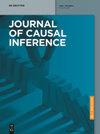关于非差分错测离散混杂因素的调整偏差
IF 1.8
4区 医学
Q2 MATHEMATICS, INTERDISCIPLINARY APPLICATIONS
引用次数: 4
摘要
生物学和流行病学现象的测量常常有误差或数据捕捉不完美。当这种不完美测量的真实状态是感兴趣的结果暴露关系的混杂因素时,以前人们普遍认为,对错误测量的观察变量进行调整,比不进行调整,对真实平均因果效应的估计偏差更小。然而,情况并非总是如此,这取决于测量和混淆的性质。我们描述了两组条件,在这两组条件下,与未调整或粗糙的估计相比,调整非服从错误测量的代理更接近无法识别的真实平均因果效应。第一组条件适用于暴露是离散的或连续的,混杂因素是有序的,对比两种治疗水平,混杂因素的结果预期是单调的。第二组条件适用于暴露和混杂因素是绝对的(名义的)。在所有情况下,错误测量必须是非微分的,因为微分错误测量,特别是未知模式,可能导致不可预测的结果。本文章由计算机程序翻译,如有差异,请以英文原文为准。
On the bias of adjusting for a non-differentially mismeasured discrete confounder
Abstract Biological and epidemiological phenomena are often measured with error or imperfectly captured in data. When the true state of this imperfect measure is a confounder of an outcome exposure relationship of interest, it was previously widely believed that adjustment for the mismeasured observed variables provides a less biased estimate of the true average causal effect than not adjusting. However, this is not always the case and depends on both the nature of the measurement and confounding. We describe two sets of conditions under which adjusting for a non-deferentially mismeasured proxy comes closer to the unidentifiable true average causal effect than the unadjusted or crude estimate. The first set of conditions apply when the exposure is discrete or continuous and the confounder is ordinal, and the expectation of the outcome is monotonic in the confounder for both treatment levels contrasted. The second set of conditions apply when the exposure and the confounder are categorical (nominal). In all settings, the mismeasurement must be non-differential, as differential mismeasurement, particularly an unknown pattern, can cause unpredictable results.
求助全文
通过发布文献求助,成功后即可免费获取论文全文。
去求助
来源期刊

Journal of Causal Inference
Decision Sciences-Statistics, Probability and Uncertainty
CiteScore
1.90
自引率
14.30%
发文量
15
审稿时长
86 weeks
期刊介绍:
Journal of Causal Inference (JCI) publishes papers on theoretical and applied causal research across the range of academic disciplines that use quantitative tools to study causality.
 求助内容:
求助内容: 应助结果提醒方式:
应助结果提醒方式:


